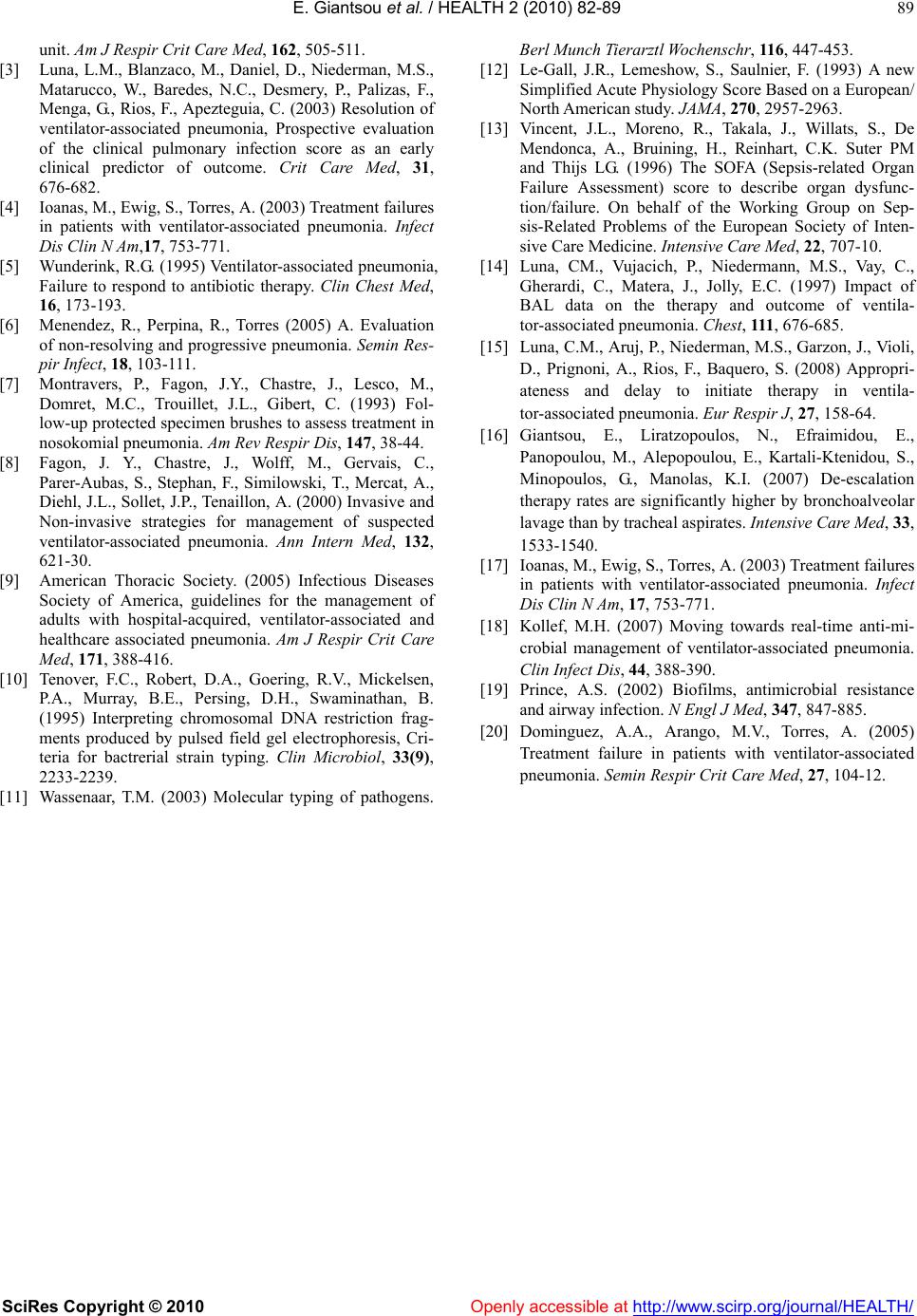
E. Giantsou et al. / HEALTH 2 (2010) 82-89
SciRes Copyright © 2010 Openl y accessible at http://www.scirp.org/journal/HEALTH/
89
unit. Am J Respir Crit Care Med, 162, 505-511.
[3] Luna, L.M., Blanzaco, M., Daniel, D., Niederman, M.S.,
Matarucco, W., Baredes, N.C., Desmery, P., Palizas, F.,
Menga, G., Rios, F., Apezteguia, C. (2003) Resolution of
ventilator-associated pneumonia, Prospective evaluation
of the clinical pulmonary infection score as an early
clinical predictor of outcome. Crit Care Med, 31,
676-682.
[4] Ioanas, M., Ewig, S., Torres, A. (2003) Treatment failures
in patients with ventilator-associated pneumonia. Infect
Dis Clin N Am,17, 753-771.
[5] Wunderink, R.G. (1995) Ventilator-associated pneumonia,
Failure to respond to antibiotic therapy. Clin Chest Med,
16, 173-193.
[6] Menendez, R., Perpina, R., Torres (2005) A. Evaluation
of non-resolving and progressive pneumonia. Semin Res-
pir Infect, 18, 103-111.
[7] Montravers, P., Fagon, J.Y., Chastre, J., Lesco, M.,
Domret, M.C., Trouillet, J.L., Gibert, C. (1993) Fol-
low-up protected specimen brushes to assess treatment in
nosokomial pneumonia. Am Rev Respir Dis, 147, 38-44.
[8] Fagon, J. Y., Chastre, J., Wolff, M., Gervais, C.,
Parer-Aubas, S., Stephan, F., Similowski, T., Mercat, A.,
Diehl, J.L., Sollet, J.P., Tenaillon, A. (2000) Invasive and
Non-invasive strategies for management of suspected
ventilator-associated pneumonia. Ann Intern Med, 132,
621-30.
[9] American Thoracic Society. (2005) Infectious Diseases
Society of America, guidelines for the management of
adults with hospital-acquired, ventilator-associated and
healthcare associated pneumonia. Am J Respir Crit Care
Med, 171, 388-416.
[10] Tenover, F.C., Robert, D.A., Goering, R.V., Mickelsen,
P.A., Murray, B.E., Persing, D.H., Swaminathan, B.
(1995) Interpreting chromosomal DNA restriction frag-
ments produced by pulsed field gel electrophoresis, Cri-
teria for bactrerial strain typing. Clin Microbiol, 33(9),
2233-2239.
[11] Wassenaar, T.M. (2003) Molecular typing of pathogens.
Berl Munch Tierarz tl Wochens chr , 11 6, 447-453.
[12] Le-Gall, J.R., Lemeshow, S., Saulnier, F. (1993) A new
Simplified Acute Physiology Score Based on a European/
North American study. JAMA, 270, 2957-2963.
[13] Vincent, J.L., Moreno, R., Takala, J., Willats, S., De
Mendonca, A., Bruining, H., Reinhart, C.K. Suter PM
and Thijs LG. (1996) The SOFA (Sepsis-related Organ
Failure Assessment) score to describe organ dysfunc-
tion/failure. On behalf of the Working Group on Sep-
sis-Related Problems of the European Society of Inten-
sive Care Medicine. Intensive Care Med, 22, 707-10.
[14] Luna, CM., Vujacich, P., Niedermann, M.S., Vay, C.,
Gherardi, C., Matera, J., Jolly, E.C. (1997) Impact of
BAL data on the therapy and outcome of ventila-
tor-associated pneumonia. Chest, 111 , 676-685.
[15] Luna, C.M., Aruj, P., Niederman, M.S., Garzon, J., Violi,
D., Prignoni, A., Rios, F., Baquero, S. (2008) Appropri-
ateness and delay to initiate therapy in ventila-
tor-associated pneumonia. Eur Respir J, 27, 158-64.
[16] Giantsou, E., Liratzopoulos, N., Efraimidou, E.,
Panopoulou, M., Alepopoulou, E., Kartali-Ktenidou, S.,
Minopoulos, G., Manolas, K.I. (2007) De-escalation
therapy rates are significantly higher by bronchoalveolar
lavage than by tracheal aspirates. Intensive Care Med, 33,
1533-1540.
[17] Ioanas, M., Ewig, S., Torres, A. (2003) Treatment failures
in patients with ventilator-associated pneumonia. Infect
Dis Clin N Am, 17, 753-771.
[18] Kollef, M.H. (2007) Moving towards real-time anti-mi-
crobial management of ventilator-associated pneumonia.
Clin Infect Dis, 44, 388-390.
[19] Prince, A.S. (2002) Biofilms, antimicrobial resistance
and airway infection. N Engl J Med, 347, 847-885.
[20] Dominguez, A.A., Arango, M.V., Torres, A. (2005)
Treatment failure in patients with ventilator-associated
pneumonia. Semin Respir Crit Care Med, 27, 104-12.